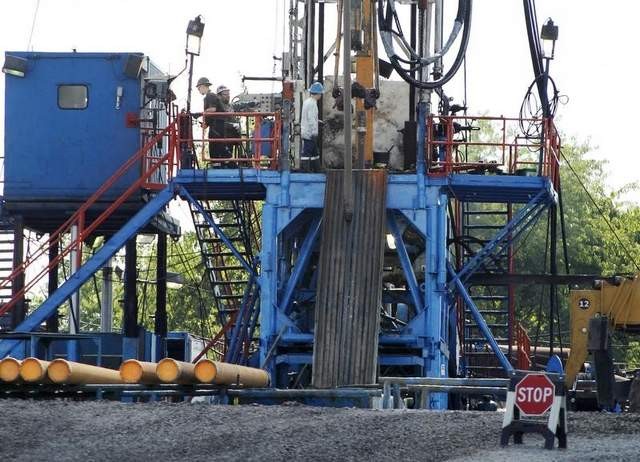New Report Highlights Fracking s Global Hazards
Post on: 16 Март, 2015 No Comment

New Report Highlights Fracking's Global Hazards
A new report, issued the same day the latest round of global climate negotiations opened in Peru, highlights the fracking industry’s slow expansion into nearly every continent, drawing attention not only to the potential harm from toxic pollution, dried-up water supplies and earthquakes, but also to the threat the shale industry poses to the world’s climate.
The report. issued by Friends of the Earth Europe, focuses on the prospects for fracking in 11 countries in Africa, Asia, North and South America and Europe, warning of unique hazards in each location along with the climate change risk posed in countries where the rule of law is relatively weak.
“Around the world people and communities are already paying the price of the climate crisis with their livelihoods and lives,” said Susann Scherbarth, climate justice and energy campaigner at Friends of the Earth Europe. “Fracking will only make things worse and has no place in a clean energy future.”
The 80-page document describes plans for fracking in Brazil’s Amazon rainforest (and the deforestation that would go along with that drilling), highlights the hazards the water-intensive process poses to already-disappearing aquifers in arid regions of northern Africa, and notes that licenses for shale gas drilling have been issued in the earthquake-prone zone at the foot of the Himalaya mountains in India.
It comes as representatives from 195 countries gathered Monday in Lima, with the goal of negotiating new limits on greenhouse gasses and staving off catastrophic climate change. Prospects for those talks seemed grim, with The New York Times reporting that it would be all but impossible to prevent the globe from warming 2 degrees.
In fact, a minimum of 3.6 degrees warming seemed “inevitable,” the paper said. adding that negotiators say their aim “is to stave off atmospheric temperature increases of 4 to 10 degrees by the end of the century; at that point, they say, the planet could become increasingly uninhabitable. “
With the stakes extraordinarily high, some fear that negotiators will turn to a superficial solution that could do more harm than good for the climate: shale gas, which gives off less of the one greenhouse gas, CO 2, at the center of climate discussions – but can leak so much of another extremely potent greenhouse gas that all of the benefits from a switch are wiped out.
“The reality is that all major climate polluters are still doing way too little to address the climate crisis,” said Jagoda Munic, chairperson of Friends of the Earth International. “Our governments are mostly focusing on false solutions and dirty energy, like fracking.”
Shale gas has already drawn backing from the Obama administration in the U.S. “If extracted safely, it’s the bridge fuel that can power our economy with less of the carbon pollution that causes climate change,” President Obama said during this year’s State of the Union address.
Unfortunately, that’s a claim that has been repeatedly debunked by peer-reviewed scientific research – with several studies showing that so much methane is currently leaking from America’s well pads, pipelines and other infrastructure that burning shale gas is worse for the climate than even burning what was long considered the dirtiest fossil fuel: coal.
The Friends of Earth report highlights the role that Obama’s State Department has played in encouraging the expansion of fracking worldwide. In April 2010, the U.S. launched a Global Shale Gas Initiative, aimed at helping countries “identify and develop” unconventional fossil fuels like shale gas. That initiative continues under a new name, the report found, the Unconventional Gas Technical Engagement Program, and has a budget for 2015 of $5.9 million, which it will split with the State Department’s Bureau of Energy Resources.
That program has played a major role in encouraging drilling behind the scenes, the report concluded. “ UGTEP uses official government channels and US taxpayers’ money to promote high-volume horizontal hydraulic fracturing worldwide, opening doors for the main global players in the oil and gas industry,” the report said. “Through UGTEP. the US is also actively engaged in re-shaping existing foreign legal regulations to create the desired legal framework for the development of shale oil and gas in the targeted countries.”
Primarily, the report warns of environmental harms in countries where the rule of law is relatively lax. “The emerging planned expansion of the shale gas industry outside the EU and North America raises serious concerns because of the almost unavoidable environmental, social and health impacts already seen at existing fracking sites,” Friends of Earth wrote. “Given that these problems have proved difficult to avoid in countries with relatively strong regulations to protect the environment, how can this industry be properly monitored in countries where environmental standards are often lower (and sometimes nonexistent), and/or where enforcement capacities are frequently limited and where corruption can be an everyday reality?”

In Mexico, the report focused on the threat of water consumption. “The majority of Mexico’s shale basins overlap with areas that are already plagued with high levels of water stress,” the report found, adding that two thirds of the shale resources lie underneath water-stressed areas. In addition, the shale formation lies beneath the Cumbres de Monterrey national park, home to delicate ecosystems and dramatic rock formations and waterfalls.
Brazil’s shale reserves are below one of the world’s largest aquifers, which extends into 3 neighboring countries, sparking fears that if it were contaminated, the impacts would stretch into Argentina, Paraguay and Uruguay.
Algeria is currently estimated to hold the third largest shale gas resources worldwide, the report notes, adding that in July, the national oil drilling company announced plans worth over $100 billion in shale gas drilling in the country over the next 5 years. But all that fracking will require vast amounts of water – in one of the most arid places on earth. “Water scarcity has already reached a critical point in the region, with Algeria and Tunisia already considered to be suffering from a severe water shortage (less than 500 m³ per inhabitant per year), and severe drought is likely in the future,” the report notes, warning of social unrest if food and water prices rise.
Last year, shale gas fracking arrived in India. “The first successful Indian shale gas exploratory well was drilled in October 2013 near Jambusar in the Cambay basin,” the report notes. But the big worry in the region centers on earthquake risk. “India is situated at the intersection between two very active plates (the Indo-Australian plate and the Eurasian plate) whose collision has created the Himalayas. As this convergence is still ongoing, it places India at the heart of a highly earthquakeprone region, which raises serious question about the risks taken by allowing fracking operations in the region.”
In Indonesia, where up to 90 percent of fault lines in some areas are considered potentially active, the earthquake hazard is matched by the risk to wildlife. “A number of Indonesia’s potential shale gas basins overlap with areas of forest which are already put under serious environmental pressure. Considering how land-intensive the shale oil, gas and coal bed methane industry can be, any potential large-scale development is likely to result in further deforestation, not least because of the need to develop new infrastructure for the industry. This would exacerbate the situation for species such as the Sumatran and Bornean orangutans which are already in danger.”
These impacts are on top of the climate changing methane leaks and the carbon dioxide released by burning natural gas itself.
“Gas has never been and never will be a clean fossil fuel,” the Friends of Earth report said. “The timeframe we now have to avoid a 2°C temperature rise obliges us to urgently look for genuinely sustainable solutions… Investing in yet more sources of fossil fuel energy will not deliver on these goals.”














